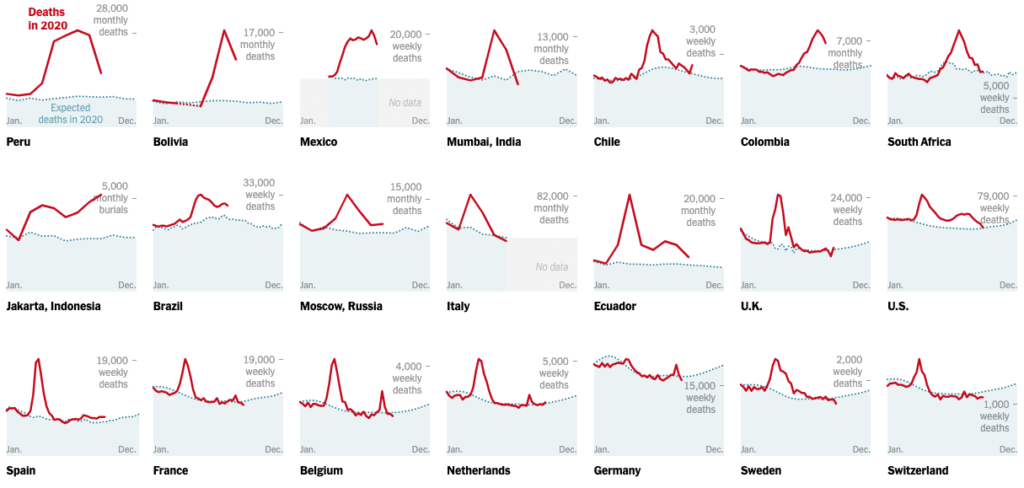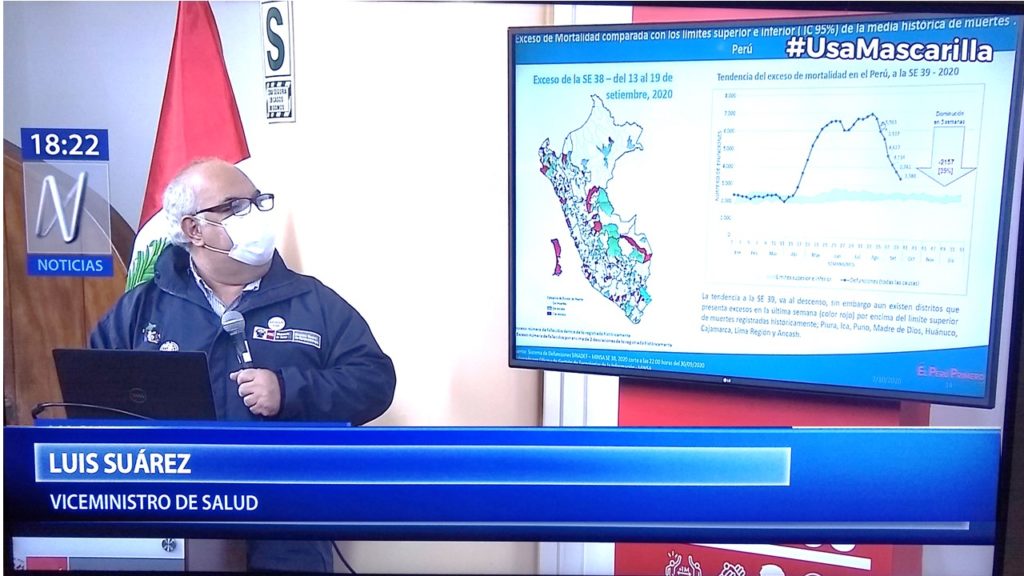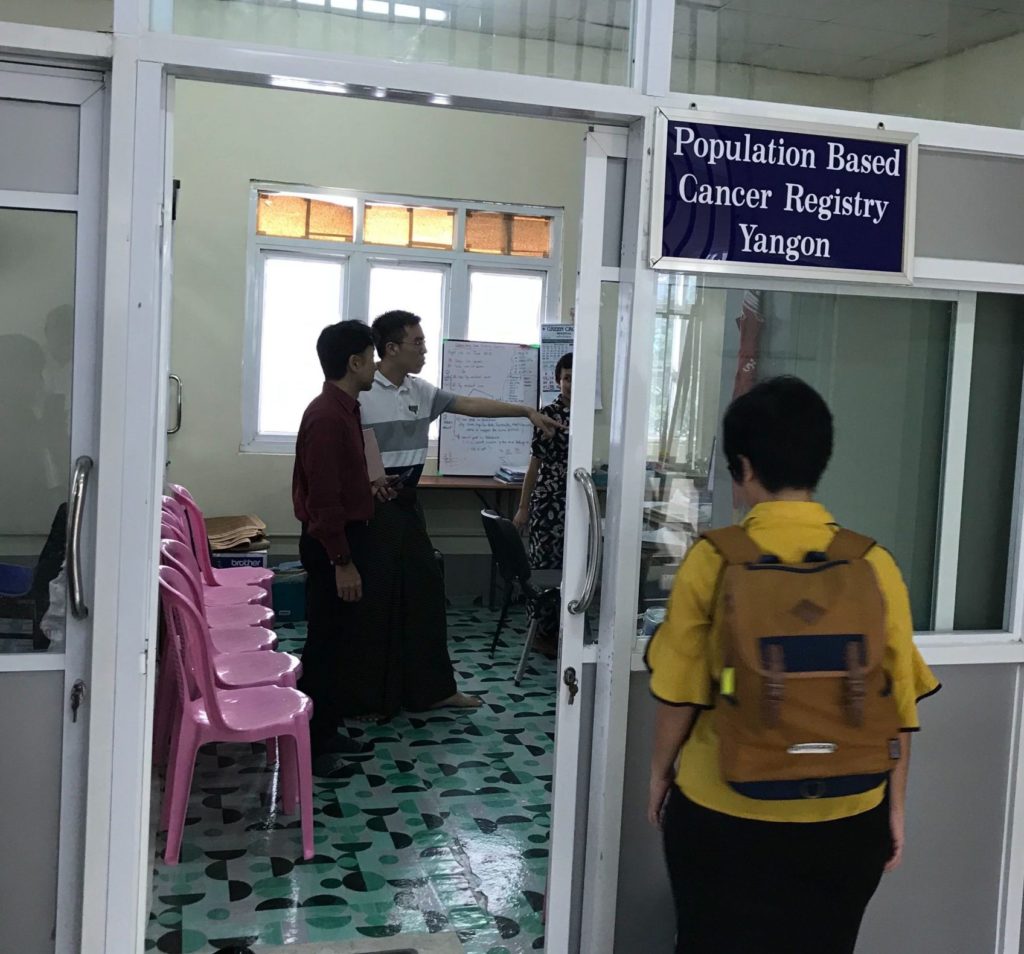The public health emergency triggered by COVID-19 has made 2020 an especially critical year for health data. From measuring excess mortality for a clearer picture of the pandemic’s human toll, to investing in robust data systems to inform government action in both the immediate and long term—it has never been more important to collect accurate and trusted data and produce timely analyses. This year many of our government partners have achieved historic data transformations that will impact people’s health for years to come.
Data and science are the foundation of public health. This year and every year, decision-makers use data to address the most pressing health issues for their communities, and to allocate resources and design policies that garner the greatest positive impact on people’s health. During the current pandemic, government leaders have based their response strategies on numbers of new cases, hospitalizations and longer-term outcomes like mortality. Here’s a look back at how our Data for Health programs have partnered with governments across the globe in 2020—to not only improve the way they access timely and accurate health information, but also to truly harness the power of data.
Improving Civil Registration and Vital Statistics (CRVS) so that every life, and death, counts
Legal and regulatory reform undertaken by our country partners this year have set the groundwork for widespread impact. For example, the burden of vital events registration in Rwanda fell on the affected family until February 2020, when a new law was enacted to allow hospital administrators to serve as registrars of births and deaths in their facilities. This official decentralization of registration services removes many of the barriers and disincentives families previously faced in submitting a formal notification of a birth or death. The country followed this landmark event with the launch of a digital civil registration system on African CRVS Day in August 2020; this will make CRVS services more accessible to rural communities, who might otherwise have to travel long distances to an authorized registration office located in a city center.
Seeing an opportunity to institutionalize best practices in CRVS, our country partners also put an emphasis on education. The Ministry of Health, Community Development, Gender, Elderly and Children in Tanzania made improvements to the training curriculum for medical colleges and universities to incorporate medical certification of cause of death (MCCD) and approved MCCD e-learning tools for continuing professional development for in-service physicians—already improving the quality of data in the Iringa region. A similar e-learning course was developed by the Ministry of Health and Social Protection in Colombia, and in Sri Lanka, a new MCCD undergraduate medical curriculum is under review for inclusion in all nine state medical faculties.

Data from the CONASS COVID-19 dashboard can be found in excess mortality trackers by The New York Times and The Economist.
State-level excess mortality data in Brazil is being used by the country’s National Council of Health Secretaries (CONASS) to educate the populace about the pandemic and combat misinformation.
The CRVS Program also supported country partners in navigating the intersection of COVID-19 response, CRVS improvement and data use. State-level excess mortality data in Brazil is being used by the country’s National Council of Health Secretaries (CONASS) to educate the populace about the pandemic and combat misinformation; the data have been included in dashboards published by The New York Times and The Economist. The Ministry of Health of Colombia has scaled up its rural vital strategy—which uses SMS messaging to notify the occurrence of deaths and collect key information—to monitor excess deaths at the community level, especially across hard-to-reach regions of the country.
Learn about the role of CRVS during a public health emergency: What is the True Human Toll of COVID-19? For Better Answers to This Critical Question, Strengthen Civil Registration Systems
Creating Data Impact by taking numbers “off the shelf” and into action
Supported by new sources of health data, government partners made important adjustments to health priorities and doubled down on public policy as a result. For example, an upcoming national report on road traffic injuries in Colombia for the first time combines multiple data sources to produce key indicators—paving the way for an evidence-based approach to shape and monitor road safety interventions across the country. A new advanced analytic unit established in the Maharashtra state of India will enhance the existing local epidemiology skillset; analytics reports, and online tools produced by the unit will help to inform policy decisions.
In Peru, a strong death registration system has allowed mortality data to become a key surveillance tool for guiding the government’s public health response to COVID-19.
Indicators on COVID-19 have served as a critical input for decisions around hospital capacity, resource allocation, and the public health and social measures put in place to slow the spread of infection. In Myanmar, a team of Data to Policy alumni appealed to the Union Minister of the Ministry of Health and Sports, establishing a COVID-19 policy analytics group to evaluate all pandemic-related policies on their epidemiological impacts and social and economic outcomes. In Peru, a strong death registration system has allowed mortality data to become a key surveillance tool for guiding the government’s public health response to COVID-19. Their Ministry of Health made use of and adapted Vital Strategies’ Excess Mortality Calculator to track all-cause mortality and generate an estimate of excess deaths; weekly reports are reviewed at the ministry’s highest levels and have been used in communicating with the public about COVID-19 mortality and response measures.

Dr. Luis Suárez Ognio, Peruvian Vice Minister of Public Health, presents excess mortality figures at a recent press conference.
Read more on rapid mortality surveillance in Peru: How One Public Health Leader Has Changed the Conversation on COVID-19
Global Grants empower countries to collect and analyze data
At the close of 2020—only 21 months after issuing its inaugural grant in March 2019—the Global Grants Program issued 33 awards in 15 countries totaling $2.8 million.
Awards this year focused on improving birth and death registration, services which ensure that citizens have official proof of their existence and that countries can take action against the leading causes of mortality within their borders. In Malawi, for example, a project with the National Registration Bureau will dramatically increase birth registrations by upgrading and providing equipment, installation and training on a new electronic registration system. A partnership with the Ministry of Health in Peru strengthened local capacity to measure the burden of disease at a regional level; differences will be incorporated into the country’s Essential Health Insurance Plan, allowing Peruvian citizens to tailor their insurance coverage based on the health issues most prevalent in their communities.
Equipped with the tools to collect and correctly report on mortality data, emergency responders in Ghana identified more than 420 additional deaths in 2020—capturing cases that might have otherwise gone unreported within the existing channels, and contributing to more complete mortality data at the national level
The Global Grants Program partnered with the Ghana Statistical Service to fill a data gap related to road traffic and violent deaths (such as homicides), two areas of mortality that are likely to be left out of cause-of-death reporting. Equipped with the tools to collect and correctly report on mortality data, emergency responders identified more than 420 additional deaths in 2020—capturing cases that might have otherwise gone unreported within the existing channels, and contributing to more complete mortality data at the national level.
New Global Grants funding is available: Learn What Makes a Successful Project
Cancer Registries are providing new insights on a leading global killer
Tanzania’s Ministry of Health led the development of the first national report on cancer incidence
Population-based cancer registries play a critical role in helping countries to better capture the burden of prevailing cancers. Working closely with cancer registry leads, the noncommunicable disease (NCD) department of the Ministry of Health, Community Development, Gender, Elderly and Children of Tanzania led the development of the first national report on cancer incidence. This stimulated demand for more consistent cancer data reporting—with the data being included in the country’s annual health planning report and a request surfacing for semi-annual reports on cancer incidence.

Work in Myanmar has also created a high demand for cancer data, with the Ministry of Health expanding support to the country’s main population-based cancer registry in Yangon as well as two others in Mandalay and Taunggyi. The newly-established central coordination unit for all cancer registration in the country is linking cancer and mortality data together for the first time, providing higher quality data on cancer as a cause of death and supporting the creation of the country’s inaugural annual cancer registry report. Efforts like these continue to improve the efficiency and transparency of data collection and management, and help to develop a better understanding of cancer in the country.
Learn more about cancer registration: Q&A with the Cancer Registries Program
Tools and Resources for COVID-19 Surveillance
Since mid-March 2020, the Vital Strategies Data for Health programs have applied their tools and expertise to COVID-19 data analysis and use—developing a series of practical tools for countries to monitor the status of the epidemic as well as the effectiveness of public health and social measures.
This technical package helps guide governments in the development, implementation and monitoring of a rapid mortality surveillance system, including how to interpret excess mortality visually.
Practical, step-by-step guidance on using existing data from respiratory disease surveillance systems and hospital-based routine data systems for early detection of COVID-19.
An Excel template with step-by-step guidance for using existing data from respiratory disease surveillance systems and hospital-based routine data systems for early detection of COVID-19.
A general roadmap for analysts, to produce and present findings on mortality patterns related to COVID-19 in their jurisdictions.
Intended for analytic staff in ministries of health who are responsible for producing data-driven insights to inform action, this brief describes essential COVID-19 indicators that should be routinely calculated, interpreted, and presented to decision-makers.
This website combines visualizations of epidemiological trends (caseloads, doubling time, deaths and case fatality ratios) with data on implementation of public health and social measures, population mobility and security incidents, for 98 countries.
Produced through the Partnership for Evidence-Based Response to COVID-19 (PERC), these reports synthesize socioeconomic, population movement, epidemiological and security indicators from 20 African Union Member States to help determine the acceptability, impact and effectiveness of public health and social measures for COVID-19.
To learn more about Vital Strategies’ Data for Health Initiative, please visit vstrategystage.wpengine.com/programs/data-for-health/ and follow us on Twitter @VitalStrat.
The Data for Health Initiative is a global effort supported by Bloomberg Philanthropies and the Australian Department of Foreign Affairs and Trade. It provides technical assistance to low- and middle-income countries worldwide to improve public health data systems at the national level, including improving civil registration and vital statistics systems, maximizing the use of data to enhance public health policymaking and decision-making, establishing and strengthening national cancer registries and more. Vital Strategies serves as an implementing partner.